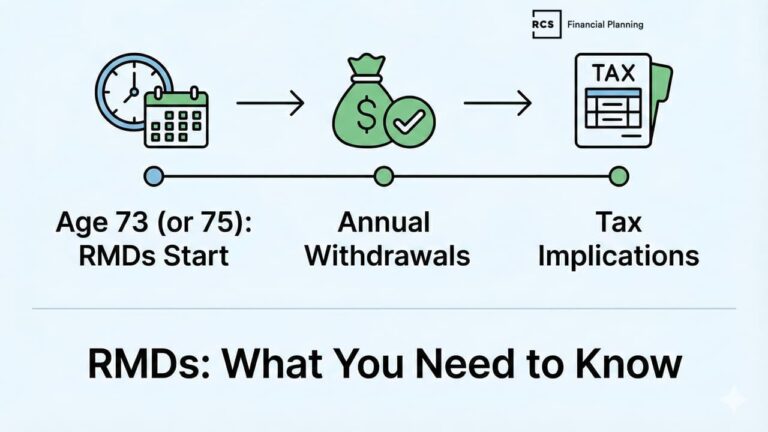Roth IRA 5-Year Rule Explained
Navigating the Roth IRA Maze: Understanding the Two Five-Year Rules
Are you considering a Roth IRA for your retirement savings? You’re not alone. Roth IRAs have become increasingly popular due to their tax advantages and flexibility. However, before you dive in, it’s crucial to understand the intricate rules that govern these accounts, particularly the two five-year rules that can significantly impact your tax situation.
The Allure of Roth IRAs
Roth IRAs offer a unique proposition: while you can’t deduct contributions, your money grows tax-free within the account. Even better, once you reach age 59½, you can typically withdraw your earnings without paying taxes. Plus, you have the flexibility to withdraw your contributions at any time without taxes or penalties.
But here’s where it gets tricky: if you withdraw earnings before age 59½, you’ll face a 10% penalty. And that’s where our two five-year rules come into play.
What is the Roth IRA 5-Year Rule?
The Roth IRA 5-year rule is actually two separate rules that determine the tax treatment of your Roth IRA withdrawals. Let’s break them down:
The First Five-Year Rule: Tax-Free Earnings Distributions
This rule determines whether your earnings distributions are tax-free. Here’s how it works:
- When the Clock Starts: The 5-year period begins on January 1 of the tax year of your first Roth IRA contribution. For example, a contribution made on April 15, 2024, for the 2023 tax year starts the clock as of January 1, 2023.
- You must wait five tax years from this point before you can withdraw earnings tax-free (assuming you’re also 59½ or older).
- The good news? This clock doesn’t restart for new contributions or new Roth IRA accounts.
Let’s look at two scenarios to illustrate:
Scenario 1: You’re 61 and opened your first Roth IRA three years ago. If you take a distribution in 2024, you’ll be taxed on the earnings because it’s been less than five years since your first contribution.
Scenario 2: You’ve had a Roth IRA since 2014 and opened a second one in 2022. Because your first Roth dates back to 2014, you can withdraw earnings tax-free from either account (as long as you’re at least 59½).
The Second Five-Year Rule: Roth IRA Conversions
The second 5-year rule applies to funds converted from a traditional IRA to a Roth IRA.
Key Points for Roth IRA Conversions
- Separate Clocks for Each Conversion: Each conversion starts its own 5-year clock on January 1 of the year the conversion is completed.
- Avoiding Early Withdrawal Penalties: If you’re under 59½ and withdraw converted amounts before the 5-year period ends, you may face a 10% penalty.
- What Happens After 59½? Once you’re 59½ or older, the penalty no longer applies, but the first 5-year rule still governs whether earnings are tax-free.
For example, if you convert a traditional IRA to a Roth at age 51 and withdraw funds four years later, you’ll not only owe taxes on the earnings but also face a 10% penalty on both the earnings and the converted principal.
How the 5-Year Rules Work Together
Understanding how these rules interact is crucial. For instance, if you convert funds at age 57, you may still face a penalty on those funds until age 62, even though you’ve reached 59½.
Frequently Asked Questions About the Roth IRA 5-Year Rule
Special Considerations
Roth 401(k) Rollovers
If you’re considering rolling over a Roth 401(k) to a Roth IRA, be aware that the 5-year rule for Roth IRAs will apply to the entire amount rolled over, regardless of how long you held the Roth 401(k).
Backdoor Roth IRA Conversions
The 5-year rule also applies to backdoor Roth IRA conversions. If you’re under 59½, you’ll need to wait five years to avoid the 10% penalty on withdrawals of converted funds.
The Bottom Line
Understanding the Roth IRA 5-year rule is crucial for maximizing the benefits of your retirement savings strategy. While these rules can seem complex, they’re designed to encourage long-term saving and discourage using retirement accounts for short-term needs.
Remember, when it comes to Roth IRAs, patience truly is a virtue. By navigating these five-year rules carefully, you can set yourself up for a more financially secure retirement.
Before making any moves, consider using a Roth IRA 5-year rule calculator or consulting with a financial advisor to ensure you’re making the most of your retirement savings strategy. The IRS provides detailed guidance on these rules, so it’s always a good idea to check their latest publications or consult with a tax professional for the most up-to-date information.
Ready for clarity and confidence in your Retirement plan?
30 minutes · No cost · No obligation
This material is provided for educational, general information, and illustration purposes only. You should always consult a financial, tax, or legal professional familiar with your unique circumstances before making any financial decisions. Nothing contained in the material constitutes tax advice, a recommendation for the purchase or sale of any security, or investment advisory services. This content is published by an SEC-registered investment adviser (RIA) and is intended to comply with Rule 206(4)-1 under the Investment Advisers Act of 1940. No statement in this article should be construed as an offer to buy or sell any security or digital asset. Past performance is not indicative of future results.






